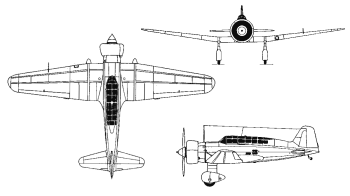



Inspired by the development of modern stressed-skin monoplanes in the United States, the Mitsubishi Ki-15 'Babs' began as a private venture sponsored by a local newspaper intended to demonstrate the full capabilities of the Japanese aircraft industry to an increasingly nationalist public. The resulting aircraft made an unprecedented 9,900 mile flight from Tokyo to London to celebrate the coronation of King George VI. Civil versions eventually led to military developments for the IJAAF and these were among the first to see combat during the Sino-Japanese conflict where their impressive speed made them invulnerable to any Chinese fighter except for Soviet-supplied I-16s. The Ki-15 was eventually used for level bombing, close support, and reconnaissance with naval units responsible for spotting the HMS Prince of Wales and HMS Repulse. Both were later relegated to second-line duties and as kamikazes.
The aircraft later known as the Ki-15 first flew in May 1936 as the Karigane (Wild Goose) and was used primarily for publicity purposes although some were built as fast mailplanes. Military production of the Ki-15-I began the following year and was followed by the improved Ki-15-II in 1939 which included an improved Ha-26 engine. A planned version with Ha-102 engines was known as the Ki-15-III but never built while a version for the IJN became known as the C5M. These included the basic C5M1 (based on the Ki-15-II) and the improved C5M2 with improved Sakae 12 engines.
Preceded by:
NoneSucceeded by:
None | |
| Design | Ki-15-I |
| Code Name | Babs |
| Type | Light Bomber |
| Year | 1937 |
| Crew | 2 |
| Dimensions | |
| Length | 27 ft 11 in |
| Height | 10 ft 8 in |
| Wing Span | 39 ft 4 in |
| Wing Area | n/a |
| Weight | |
| Empty | 3,086 lbs |
| Maximum | 5,071 lbs |
| Wing Loading | 23.1 lb/ft² |
| Performance | |
| Speed | 298 mph |
| Ceiling | 37,402 ft |
| Range | 1,491 mi |
| Powerplant | |
| Engine | 1 x Ha-8 Nakajima 750 hp |
| Thrust/Weight | 0.49 |
| Armament | |
| Guns | 2 x 7.7-mm |
| Payload | 551 lbs |
| Production | |
| Built | n/a |
| Total | 500 |